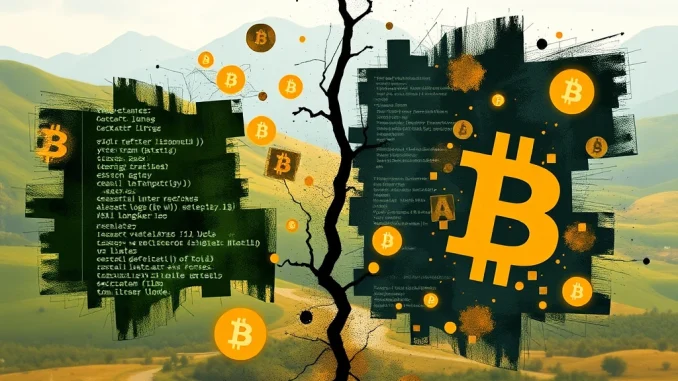
A significant discussion is brewing within the Bitcoin community, centered around a technical but impactful proposal: lifting the 80-byte limit on the Bitcoin OP_RETURN function. This seemingly small technical detail has ignited a debate that touches upon Bitcoin’s core principles, its future use cases, and echoes past controversies like the Ordinals phenomenon.
Understanding the OP_RETURN Limit
What exactly is OP_RETURN, and why does its limit matter? At its heart, Bitcoin is a ledger for financial transactions. However, the scripting language allows for some flexibility. OP_RETURN is an opcode (a command) that marks a transaction output as provably unspendable. Its primary use is to allow users to embed a small amount of arbitrary data directly onto the blockchain.
- Original Purpose: Primarily intended for attaching metadata relevant to a transaction, such as proof-of-existence for a document hash, or linking to off-chain data.
- The Limit: For many years, the standard policy limit for data embedded using OP_RETURN has been 80 bytes. This limit was introduced to prevent abuse and keep the blockchain size manageable by discouraging the storage of large, non-financial data.
- How it Works: A transaction output contains an OP_RETURN script followed by the data itself. Because the output is unspendable, these UTXOs (Unspent Transaction Outputs) are pruned from node databases, helping to manage state bloat, although the data remains permanently on the blockchain history.
The current discussion revolves around whether this OP_RETURN limit is still necessary or if it has become an outdated restriction in the face of new developments.
The Proposal: Why Lift the OP_RETURN Limit?
A segment of Bitcoin developers and users argues that the 80-byte restriction is arbitrary and hinders potential innovation. They propose increasing or entirely removing this limit.
The core arguments from supporters often center on:
- Outdated Restriction: The limit was set at a time when embedding any data was viewed with more skepticism. Technology and usage patterns have evolved.
- Taproot and Ordinals Precedent: The advent of Taproot (BIPs 340, 341, 342) and subsequent innovations like Ordinals and inscriptions have shown that users can already embed significantly larger amounts of data (images, text, etc.) onto the blockchain, albeit through different scripting methods (witness data). Supporters argue that since large data is already being stored, maintaining a strict limit on OP_RETURN is inconsistent and serves little purpose in preventing blockchain bloat compared to other methods now in use.
- Potential New Use Cases: A higher limit could enable simpler methods for certain types of data embedding for applications like decentralized identifiers (DIDs), timestamping services, or other forms of metadata attachment without needing more complex Taproot scripts for small to medium data sizes.
They see it as a way to make data embedding slightly more accessible or flexible for specific purposes, aligning OP_RETURN’s capability more closely with what is already de facto possible on the network.
The Opposition: Concerns Over Bitcoin Data and Integrity
Not everyone agrees that lifting the OP_RETURN limit is a good idea. Critics, including prominent Bitcoin Core developer Luke Dashjr, voice strong opposition, raising concerns that mirror previous debates about non-financial data on the chain.
Key concerns from opponents include:
- Potential for Abuse: A major fear is that a higher limit would make it easier and cheaper to store large amounts of arbitrary, potentially illegal or harmful content (like child pornography or copyrighted material) immutably on the blockchain, creating significant legal and ethical headaches for node operators and the ecosystem.
- Increased Blockchain Size and Sync Time: While OP_RETURN outputs are pruned, the data is still part of the historical blockchain data that full nodes must download and validate initially. Increasing the amount of data per OP_RETURN transaction could contribute to blockchain growth and increase the resources required to run a full node, potentially impacting decentralization.
- Harm to Financial Integrity: Critics argue that Bitcoin’s primary purpose is peer-to-peer electronic cash. Encouraging or making it easier to store non-financial Bitcoin data fundamentally shifts its focus and could dilute its intended function, potentially harming its long-term financial integrity and censorship resistance profile by attracting unwanted attention for data storage rather than monetary transfer.
- Setting a Precedent: Relaxing one limit might lead to pressure to relax others, potentially opening a Pandora’s Box for further changes that could alter Bitcoin’s fundamental characteristics.
They emphasize maintaining Bitcoin’s purity as a financial network and avoiding features that could introduce unnecessary risk or bloat.
Echoes of the Ordinals Debate
As CoinDesk noted, this discussion feels remarkably similar to the Ordinals debate that captured the community’s attention in 2023. That controversy arose from the use of Taproot and witness data to inscribe arbitrary data (creating “digital artifacts” or “inscriptions”) onto individual satoshis.
| Feature | OP_RETURN | Ordinals/Inscriptions (via Taproot) |
|---|---|---|
| Data Limit (Current) | 80 bytes (policy) | Significantly larger (limited by block size) |
| Data Location | In scriptPubKey (output) | In witness data (input) |
| UTXO Status | Provably unspendable (pruned) | Creates spendable UTXOs (not pruned) |
| Controversy Link | Current debate topic | Precedent cited by proponents of lifting OP_RETURN limit |
Supporters of lifting the OP_RETURN limit point to Ordinals as proof that the desire and technical capability to store larger data on-chain already exist and are being utilized. They argue that the OP_RETURN method is arguably ‘cleaner’ for certain data types as it creates unspendable outputs that are pruned from the UTXO set, unlike inscriptions which create new UTXOs that contribute to UTXO set growth.
Opponents, however, see both as symptoms of the same problem: using Bitcoin for something other than money, leading to blockchain bloat and potential regulatory/ethical issues. The Ordinals debate highlighted the tension between Bitcoin’s immutability and the desire to use it for novel applications, a tension clearly visible in the current OP_RETURN discussion.
What Happens Next in the Bitcoin Developers Debate?
This isn’t a simple code change; it’s a policy debate among Bitcoin developers, node operators, and the broader community. Changes to Bitcoin’s consensus rules or even standard policy rules require broad consensus and careful consideration due to the network’s decentralized nature.
The discussion is likely to continue across mailing lists, developer calls, and social media. There is no central authority to mandate a change. Any significant shift would need to be implemented in Bitcoin node software and adopted by a majority of the network’s participants.
Conclusion: Navigating Bitcoin’s Future Data Landscape
The debate over the Bitcoin OP_RETURN limit is more than just a technical quibble; it’s a microcosm of the ongoing tension within the Bitcoin ecosystem regarding its purpose and future direction. It pits those who see Bitcoin’s blockchain as a robust, immutable data layer open to various uses against those who believe it should strictly remain a minimalist financial transaction network.
While the technical implications regarding Bitcoin data storage and blockchain size are significant, the philosophical divide is perhaps more profound. As with the Ordinals debate, finding a path forward will require navigating deeply held beliefs about what Bitcoin is and what it should become. The outcome of this discussion could influence how data is embedded on Bitcoin and signal the community’s evolving stance on non-financial use cases.
This is a crucial conversation for anyone interested in the technical underpinnings and governance of the world’s leading cryptocurrency.



